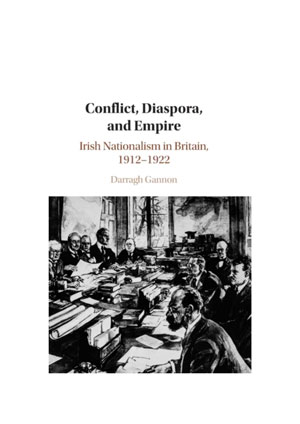
DARRAGH GANNON
Cambridge University Press
€98
ISBN 9781009158299
REVIEWED BY Charles Townshend
Charles Townshend is Professor Emeritus of International History at Keele University.
The Irish in twentieth-century Britain have attracted plenty of attention from historians and are now being subjected to ever-closer scrutiny; in recent years a series of studies have appeared—foremost amongst them, perhaps, Mo Moulton’s gripping Ireland and the Irish in interwar England and Gerard Noonan’s substantial work on the IRA in Britain during the War of Independence, published ten years ago. Mary MacDiarmada’s semi-biographical study of the kingpin of nationalist organisations in Britain, Art O’Brien—‘the God of our small world’—appeared in 2020. Here Darragh Gannon provides an account of the Irish community in Britain—never abridged into hyphen form like Irish-Americans—with the aim of showing that its role in the Irish revolution was more active than has usually been thought.
While MacDiarmada focused on O’Brien’s ‘life experience rather than the history of a movement’, Gannon opts for the opposite approach. Important as the Ó Briain papers surely are, he says, ‘over-reliance on assembled personal papers can be problematic, the predominance of the archived individual obscuring alternative views and voices’. He aims to ‘interrogate’ that archive alongside numerous other extensive sources, such as the Catholic Herald, a syndicated newspaper with a circulation ‘in the millions … widely read amongst the Irish in Britain’ (‘particularly among those of Irish descent’, he oddly adds—were there some Irish of non-Irish descent?).
This approach certainly delivers an impressive mass of primary material, and in documentary terms this book provides the most extensive and substantial study of the Irish community in the revolutionary decade. A somewhat scatter-shot delivery, however—hefty paragraphs where successive quotations make different or even contradictory points—means that it can read more like preliminary notes than finished text. While the detail can be fascinating, key themes remain elusive. ‘Diasporic nationalism’, for instance, which is central to his aim of tracing the reciprocal impact of the British environment on the evolution of Irish nationalism itself, is a notoriously complex and unstable mix (as Alan O’Day’s attempt to profile the ‘mutative ethnicity’ of the Irish diaspora has shown) and calls for more precise conceptual clarity than it gets here.
Dominant individuals, too, like T.P. O’Connor (living testament to the political heft of the Liverpool Irish community), Charles Diamond, editor of the Catholic Herald, and, indeed, Art O’Brien himself tend to appear obliquely and never quite come into focus. Diamond, for instance, making (in relation to the ‘People’s Budget’ in 1910) a crucial point—that the Irish people in Britain should ‘do all in their power for Ireland consistent with some recognition of their own interests and their own rights’—invites perhaps a more systematic analysis.
Questions about the unity and political effectiveness of the Irish in Britain remain, as does the question of how successful Irish organisations like O’Brien’s Irish Self-Determination League were in persuading British public opinion to support Home Rule. Was there any traction in the Redmondite MP William O’Malley’s invocation of ‘reconciliation and a real union between the Irish and British peoples’? Or the ‘latent loyalty’ of the Irish invoked by John Esmonde (MP for North Tipperary), a concept awkward enough even before the demand for ‘de-Anglicisation’ increasingly permeated Irish nationalism? By suggesting that Redmond ‘represented Home Rule as the language of political citizenship in Britain’, Dr Gannon seems to imply that he succeeded, but there is more evidence that the British public did not accept Home Rule—hence Tory insistence that as a major constitutional change it required an ‘English majority’ to pass, which they knew would not emerge.
The book ends, chronologically but perhaps also logically, with an evaluation of the IRA in Britain. Dr Gannon’s central argument is that it was more than marginal or epiphenomenal—even perhaps in operational terms, and certainly in terms of securing arms supplies for Ireland. He argues that, rather than (as in Peter Hart’s view) operating in small centres, the IRA in Britain was a fully functional national system. Yet he also shows that it was at best a very mixed bag, with many of its units being judged useless by their chiefs and lacking consistent support from the Irish community. Many Liverpool Irish were alienated by ill-judged IRA attacks, while O’Brien dismissed the London IRA as ‘a farce’.
Gannon’s argument is stronger in relation to arms supply, where he builds a picture of a much more coherent system than previous historians have found, even reaching for the word ‘prolificacy’ to describe its throughput. Still, to say that ‘as early as spring 1920, Joe Vize’s safe houses could no longer adequately store the sheer volume of arms, ammunition and explosives reaching Glasgow’ remains imprecise, like the information that ‘two carloads per week were required to reduce Glasgow’s stock of rifles’. How many in each house, each car? And where did they go? He accepts Michael Hopkinson’s verdict—which surely does not support his argument—that the IRA’s shortage of arms, and especially ammunition, remained ‘chronic’ in 1921. Likewise, he seems to accept Hart’s estimate of the totals passed through Liverpool in the whole pre-Truce period (less than 25,000 rounds of ammunition, for example), which would not have gone far.
Did the IRA campaign in Britain remain essentially a sideshow, as Hart thought, or take centre stage, as Gannon proposes? Whether one accepts his evaluation of its gunrunning role in preference to Noonan’s more cautious verdict seems for now to be a matter of inclination rather than conclusive demonstration.
